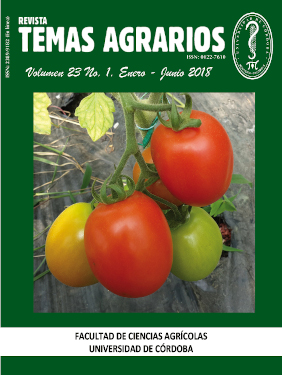Pesticides district irrigation canals of La Doctrina (Córdoba-Colombia)
Plaguicidas en canales de riego del distrito de La Doctrina (Córdoba-Colombia)

This work is licensed under a Creative Commons Attribution-NonCommercial 4.0 International License.
Show authors biography
La Doctrina district makes a great contribution to Colombian economy with production of several crops such as rice (1230 ha), corn (50 ha), African palm (300 ha), papaya (10 ha), vegetables (8 ha), and pastures (400 ha). To control pests in the crops farmers use organochlorine and organophosphate pesticides in irrigation channels, contaminating drinking water. This work sought to determine the concentrations of organochlorine (POCls) and organophosphate (OP) pesticide and cypermethrine (CP) in irrigation channels of La Doctrina during dry and rainy seasons. Analyses were performed by gas chromatography and gas-mass. CP was detected by monitoring of technique SIM of mass spectrometry, and POCls and POFs were analysed by electron capture detector (ECD) and nitrogen-phosphorus (NPD) respectively. The results showed that all concentrations of cypermetrin (in the dry and rainy seasons) overcome the accepted concentrations in Colombian regulations for drinking water. Also, according to Argentinan regulations, all exceeded this limit. The POCl endrins exceeded the limit allowed for Colombian regulations, but POFs were not found. The percentage of cypermethrin was the highest, with 73%. The high concentrations of the POCls and CP in irrigation water of La Doctrina district motivated us to determine the concentrations of these pesticides in typical foods from the region such as rice.
Article visits 1638 | PDF visits
Downloads
- Bonansea, R., Amé, M. y Wunderlin, D. 2013. Determination of priority pesticides in water samples combining SPE and SPME coupled to GC–MS. A case study: Suquía River basin (Argentina). Chemosphere 90(6):1860-1869. https://doi.org/10.1016/j.chemosphere.2012.10.007
- CIOH (Centro de Investigaciones Oceanográficas e Hidrográficas). 1992. Monitoreo de la contaminación en el Caribe colombiano: petróleo, pesticidas y desechos sólidos flotantes. Informe final Proyecto N1 17.
- EPA (Environmental Protection Agency). 2002. Cypermethrin and an Isomer Zeta-cypermethrin; Pesticide Tolerances for Emergency Exemptions. https://www.federalregister.gov/articles/2002/09/04/02-22606/cypermethrin-and-an isomer-zeta-cypermethrin-pesticide-tolerances-for-emergency-exemptions#p-21. [9 de Abril del 2002].
- FAO (Organización de las Naciones Unidas para la Agricultura y la Alimentación). 2002. Programa de Desarrollo Sostenible de la Región de la Mojana. Departamento de Planeación Nacional, Bogotá, 207p.
- EPA (Environmental Protection Agency). 2008. Method 3510, cipermetrina's determination in water. http://www.epa.gov/lead/pubs/lppw2008sp.htm. [21 de mayo de 2008].
- FEDEARROZ (Federación Nacional de Arroceros). 2008. Guía para el crecimiento agronómico en Córdoba. http://www.fedearrozagro.com [14 de julio 2008].
- Feo, G., Eljarrat, E., Barceló, D. 2010. Presence of pyrethroid pesticides in water and sediments of Ebro River Delta. Journal of Hydrology (393):156-162. https://doi.org/10.1016/j.jhydrol.2010.08.012
- GEUN (Grupo de estudiantes de la universidad Nacional). 2008. Plaguicidas: Impactos Socioeconómicos en Colombia. Memorias III. Seminario Nacional Aconteceres Entomológicos. Universidad Nacional de Colombia, Bogotá, Abril del 2008, p1-19.
- ICA (Instituto Colombiano Agropecuario). 2000. Comercialización de plaguicidas: Importación, Producción, Ventas y Exportaciones en 1998. División de Insumos Agrícolas. Produmedios.
- INECC. (Instituto Nacional de Ecologia y Cambio Climatico). 2004. Fichas técnicas de los Herbicidas incluidos en el catálogo CICOPLAFEST 2004. http://www2.inecc.gob.mx/sistemas/plaguicidas/busquedas.html. [11 de mayo del 2012].
- Jergentz, S., Mugni, H., Bonetto, C., Schulz, R. 2005. Assessment of insecticide contamination in runoff and stream water of small agricultural streams in the main soybean area of Argentina. Chemosphere (61):817-826. https://doi.org/10.1016/j.chemosphere.2005.04.036
- Kamel, A., Byrne, C., Vigo, C., Ferrario, J., Stafford, C., Verdin, G. 2009. Oxidation of selected organophosphate pesticides during chlorination of simulated drinking water. Water Research 43(2):522-534. https://doi.org/10.1016/j.watres.2008.10.038
- Kocaman, A., Topaktaş, M. 2009. The in vitro genotoxic effects of a commercial formulation of alpha-cypermethrin in human peripheral blood lymphocytes. Environmental and Molecular Mutagenesis (50):27-36. https://doi.org/10.1002/em.20434
- Kuranchi, H., Atiemo, S., Arthur, S., Fosu, P. 2012. Determination of organochlorine pesticide residue in sediment and water from the Densu river basin, Ghana. Chemosphere 86(3):286-292. https://doi.org/10.1016/j.chemosphere.2011.10.031
- Malaguerra, F., Albrechtsen, H., Thorling, L., Binning, P. 2012. Pesticides in water supply wells in Zealand, Denmark: A statistical analysis. Science of The Total Environment (414):433-444. https://doi.org/10.1016/j.scitotenv.2011.09.071
- Marino, D., Ronco, A. 2005. Cypermethrin and chlorpyrifos concentration levels in surface water bodies of the Pampa Ondulada, Argentina. Bulletin Environmental Contamination Toxicologic (75):820-826. https://doi.org/10.1007/s00128-005-0824-7
- Minambiente (Ministerio de Ambiente, Vivienda y Desarrollo Territorial). 2007. Resolución 2115. Por medio de la cual se señalan características, instrumentos básicos y frecuencias del sistema de control y vigilancia para la calidad del agua para consumo humano. Ministerio de Ambiente, Vivienda y Desarrollo Territorial, Bogotá, 2p.
- Nasterlack, M. 2011. Pesticide Exposure and Human Cancer. Encyclopedia Environmental Health 412-418.
- Nasuti, C., Falcioni, M., Nwankwo, I., Cantalamessa, F., Gabbianelli, R. 2008. Effect of permethrin plus antioxidants on locomotor activity and striatum in adolescent rats. Toxicology (251):45-50. https://doi.org/10.1016/j.tox.2008.07.049
- Lans, E., Marrugo, J., Díaz, B. 2008. Estudio de la contaminación por pesticidas organoclorados en aguas de la Ciénaga Grande del Valle Bajo del Rio Sinú Colombia. Revista Temas Agrarios 13(1):49-56.
- OMS (Organización Mundial para la Salud. 2003). Endrín in drinking-water. Documento de referencia para la elaboración de las Guías de la OMS para la calidad del agua potable. Ginebra (Suiza).
- Pitarch, A. 2001. Desarrollo de metodología analítica para la determinación de plaguicidas organofosforados y organoclorados en muestras biológicas humanas. Tesis doctoral, Universidad de Jaume I de Castellón, Castellón.
- Shen, M., Kumar, A., Ding, S., Grocke, S. 2012. Comparative study on the toxicity of pyrethroids, α-cypermethrin and deltamethrin to Ceriodaphnia dubia. Ecotoxicology and Environmental Safety (78):9-13. https://doi.org/10.1016/j.ecoenv.2011.07.018
- Varca, L. 2012. Pesticide residues in surface waters of Pagsanjan-Lumban catchment of Laguna de Bay, Philippines. Agricultural Water Management (106):35-41. https://doi.org/10.1016/j.agwat.2011.08.006




















